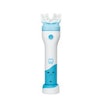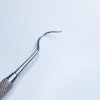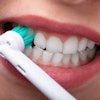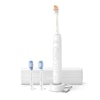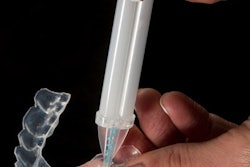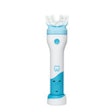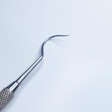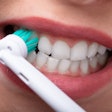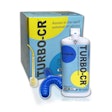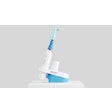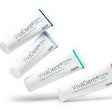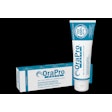
A novel radiofrequency toothbrush left teeth whiter and worked better against tooth stains than a sonic vibrating toothbrush, according to a study published in the Journal of the American Dental Association.
Consumers and patients have a strong demand for tools to keep teeth healthy and to remove stains, which is a common issue for people who use tobacco or drink coffee. With the new study, lead author Dr. Bennett Amaechi, PhD, of the University of Texas Health San Antonio School of Dentistry, and colleagues aimed to discover whether that whitening and cleaning power could be delivered by a radiofrequency toothbrush.
"The [radiofrequency] toothbrush produced substantial benefits in the reduction of tooth stains and whitening of tooth shade compared with a powered toothbrush that earned the American Dental Association Seal of Acceptance," the authors wrote (JADA, December 29, 2021).
Radiofrequency vs. sonic toothbrush
The researchers tested the Silk'n ToothWave radiofrequency toothbrush (Home Skinovations) against the CVS Health SmileSonic Pro Advanced Clean sonic toothbrush (Ranir). Silk'n first debuted its radiofrequency toothbrush at the 2020 Consumer Electronics Show (CES) in Las Vegas, touting the technology as a reinvention of the toothbrush.
ToothWave uses low-power radiofrequency energy that streams between two electrodes and over a silicon barrier to reach the tooth surface during toothbrushing. In contrast to ToothWave, which is nonabrasive, vibrating toothbrushes such as the CVS Health SmileSonic Pro rely on the abrasive mechanical movement of the bristles on the tooth surface.
The researchers conducted a single-blind study for six weeks. Participants were divided into two groups: One was given a radiofrequency toothbrush and the other a sonic vibrating toothbrush.
Candidates for the study were evaluated for tooth stains and tooth shade before being chosen to participate. A total of 91 participants were then randomized into the study (47 to the ToothWave test group and 44 to the SmileSonic control group). In the end, 86 of the participants completed the study.
Participants brushed their teeth twice a day using the assigned toothbrush and fluoridated toothpaste. At the end of the test, the toothbrushes were evaluated for their stain removal and whitening effectiveness.
The researchers used the Lobene Stain Index (LSI) and Vita Bleachedguide 3D-Master shade guide to analyze tooth stains and shades. The Vita Easyshade Advance 4.0 spectrophotometer was also used. The percentage reduction from the baseline was compared between the two groups.
The group that used the radiofrequency toothbrush experienced a significantly greater reduction of extrinsic stains than the sonic toothbrush group. Six weeks into the study, the reduction was eight times higher in the test group than the control group. The researchers also found a greater percentage improvement in tooth shade.
"We found that the [radiofrequency] toothbrush provided a substantial reduction in extrinsic teeth stains and whitening of teeth shade as measured using the LSI and [Vita] Bleachedguide [3D-Master] shade guide," the authors wrote.
A questionnaire also showed that more than 95% of participants in the test group were highly satisfied with the toothbrush, compared with 76% in the control group, the authors reported.
Some tooth stains were hard to remove with either manual or powered toothbrushes, but they were improved by the radiofrequency toothbrush, Amaechi and colleagues noted. Furthermore, the nonabrasive radiofrequency toothbrush managed to avoid damage to the tooth's enamel and soft tissue while whitening the teeth.
"Although the effect of the [radiofrequency] energy is not based on abrasive forces, it increases the efficacy of stain removal and whitening compared with mechanical movement alone and improves the tooth appearance while avoiding damage to the enamel layer and soft tissue," the authors concluded.
